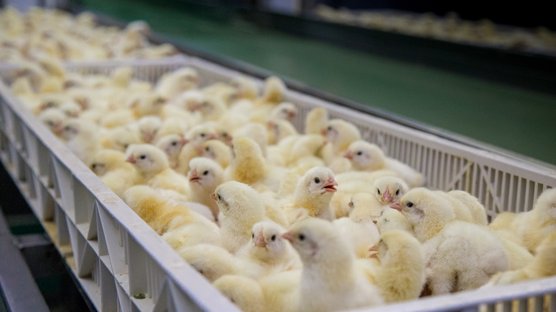
Published on Nov. 16, 2020
In-Ovo sexing technologies in hatching eggs
It is common practice in the layer industry to cull male day-old-chicks directly after hatching. Male layers are unsuitable for egg production and too resource-inefficient for meat production. The practice, however, does raise concerns about animal welfare. An increasing number of initiatives are working on a solution for this challenge by developing technologies to determine the gender of a chicken while still in the egg. Since 2012, Hendrix Genetics has been actively monitoring developments in this field. In this article, we would like to share the latest updates and technologies closest to the market.
The potential of in-ovo sexing
Solving this challenge has the potential to both address animal welfare concerns and increase sustainability by saving resources. Hatching birds is an energy intensive process, so being able to identify the gender of a chick while it is still in the egg promotes both animal welfare and energy efficiency.
Expected speed of adoption
Our expectation is that as soon as a commercially viable solution becomes available, adoption will start. Germany is expected to be one of the first countries where the technology will be widely adopted. According to a recent court ruling, use of the technology will become mandatory as soon as it is commercially viable. Once that point is reached, other countries in Northwestern Europe may follow. Our current expectation is that the North American market may be slightly later in adopting the technology, but this can change quickly when large retailers and food companies decide to demand its use from their suppliers. We also know that not all markets will accept in-ovo sexing technologies, as the development of life is still disrupted (despite the earlier stage). We already observe a vast growth in the market of growing the male layer chicks for their meat. The organic market in Western Europe expected to adopt fully the growth of the male layer chicks for their chicken meat.
Differences between technologies
When looking at the in-ovo sexing technologies in this field it is important to have an eye for the following aspects:
- Invasive or non-invasive: Some technologies require making a hole in the egg. This is a concern, since it creates a risk for contamination and lower hatchability. Therefore, non-invasive technologies are preferred.
- High accuracy: The technology must be very accurate in determining the gender. The accuracy needs to be in line with existing levels of accuracy when sexing chicks after they hatch.
- The sooner the better: The sooner the sex can be determined in the egg the better. To address animal welfare concerns, eggs should be sexed before the age of pain sensation. Although scientists disagree about the exact number of days at which pain is felt, it is clear sooner is better. Obviously, the optimal solution, both for animal welfare and efficiency, would be to do in-ovo egg sexing pre-incubation.
- High speed of sexing eggs: To function in a commercial hatchery, the speed at which eggs need to be sexed must be very high. This is particularly important if sexing happens when eggs have already been in the incubator - to prevent them from losing too much heat. So, technologies need to operate at high speed.
- Small and robust equipment required (for hatchery environment): Going from a laboratory set-up to a commercial hatchery operation is a very difficult step to take. Successful integration in a hatchery requires a robust and easy to clean machine. The technology will have to be fitted in existing facilities.
Ongoing initiatives and their approaches
An ever-increasing number of initiatives are trying to determine the sex of a chicken before they hatch. Hendrix Genetics is actively following the most promising of these around the world. Several different approaches on in-ovo sexing are being tested:
- Spectroscopic detection: Spectroscopy is the technique of splitting light (or more precisely electromagnetic radiation) into its constituent wavelengths (a spectrum) in much the same way as a prism splits light into a rainbow of colors. It requires shining a light beam of laser through the eggshell or a hole in the egg. Via image analysis, the gender is determined. Although training the software to be sufficiently accurate requires tremendous amounts of data and therefore time, this technology does offer the prospect of early identification.
- Biomarker detection: This form of analysis requires taking a fluid from the egg, mixing it with a biomarker, and analyzing the resulting sample. In most cases, allantoic fluid is withdrawn. The fluid is then used for a test that allows to see the gender. There are several different tests being investigated or developed. Most of these tests work after day 7 or 8.
- Gene editing: A few projects are working on a solution using gene editing. The regulatory framework for this is still unclear as is consumer acceptance. On the other hand, if it were to be widely accepted, the benefits of such a technology would be that it is non-invasive and provides opportunity for pre-incubation egg sex detection.
Technologies closest to the market
This list is by no means exhaustive, but it is a selection to demonstrate the variety of approaches.
- Seleggt
The first company to reach the market was Seleggt. Since November 2018, eggs have been sold under the consumer brand Respeggt. The Respeggt label promises: “Free of Chick Culling”. They launched in 200+ supermarkets in the Berlin area and have since significantly expanded their coverage of the German market. Since the summer of 2019, the eggs are also available in Carrefour supermarkets in the Paris region in France. and since 2020 also in the Netherlands. The price is comparable to a free-range egg.
The in-ovo sexing technology has been developed in a joint venture between German retailer the REWE group, Dutch technology company HatchTech, and professor Einspanier from the University of Leipzig. On day 8 of the incubation, a laser beam burns a 0.3mm-wide hole in the shell. Then, air pressure is applied to the shell exterior, pushing a drop of fluid out of the hole. This fluid is analyzed using a proprietary biomarker, which allows them to determine the sex.
- In Ovo
The Dutch In Ovo company was founded in 2013 by biomedical scientist Wil Stutterheim and biologist Wouter Bruins, who met at the University of Leiden. The in-ovo sexing technology they use is based on biomarkers and is invasive. A sample is taken from each egg, mixed with a biomarker, and examined by mass spectrometry. At the end of 2018, Evonik and VisVires New Protein invested in In Ovo, along with the participation of Leiden University. With the investment capital, In Ovo plans to develop the technology to the stage where it can be applied on the commercial scale in hatcheries. Read more: https://inovo.nl/
- PLANTegg
The aim of the PLANTegg innovative process is the gender determination in chicken eggs. This avoids the killing of hatched male day-old chicks in hatcheries during the production of laying hens. New technologies have been developed and combined for the so-called PLANTegg process - a PCR-based method for gender determination of hatching eggs. This molecular genetic method is based on the fact that the chickens have different gender chromosomes. The PCR technology makes the genetic differences, to be found in the DNA of the allantoic fluid, visible. The gender can thus be determined at an early stage of incubation with high precision and very quickly (within one hour). The eggs from which male chicks would hatch can then be sorted out early and used for other purposes. The method can be automated, is infinitely scalable and can therefore be used in both small and large hatcheries. Read more: https://www.plantegg.de/en/
- Hypereye
Hypereye is a patented scanning in-ovo sexing technology that uses non-invasive hyperspectral imaging. This is done at day 0, pre-incubation. The technology was developed by Michael Ngadi at McGill University in Canada, with funding from Ontario Poultry Industry Council, Egg Farmers of Ontario and Livestock Research Innovation Corporation. They are currently testing prototypes to achieve the same accuracy and speed at a commercial scale as seen in the laboratory.
Potential source of new initiatives on in-ovo sexing
While ongoing initiatives on in-ovo sexing continue developing their technology further, from the laboratory to a commercial prototype, to eventually reach the market, new projects and initiatives keep popping up. In many cases, these new entrants are supported with funding from industry and governments.
One such source of new initiatives on in-ovo sexing is the competition organized by the Foundation for Feed and Agriculture Research (FFAR). They are awarding an Egg-Tech Prize to help organizations and individuals solve the scientifically and technologically complex issue of identifying the sex of a chick in the egg prior to certain embryo developmental milestones.
At the end of 2019, they announced that in Phase I of the competition, they awarded USD $1,056,957 to six organizations. Participating researchers are from around the globe and include academics, private research companies, and USDA Agriculture Research Service. The methods on in-ovo sexing these different groups will explore are diverse and include volatile organic compounds, reaction mass spectrometry, and magnetic resonance imagining. In Phase II of the prize competition, contestants will develop and validate a working prototype that meets the criteria that are set. FFAR will accept Phase II submissions in early 2021.
Our approach
We are hopeful that new technologies on in-ovo sexing will put an end to male chick culling in the supply chain. As Hendrix Genetics, we are actively following these developments on in-ovo sexing, so we know what is coming to market and can prepare ourselves for it. We also work together with promising initiatives to support their development in finding a solution for this significant poultry industry issue. A breakthrough would provide great opportunity for enhanced animal welfare, efficiency, quality, and an overall more sustainable industry for us all. In the mean time we continue to collaborate with SASSO on the development of Dual Purpose poultry breeds. Learn more about SASSO and their slow-growing broiler activities: https://europe.sasso-poultry.com/en/




